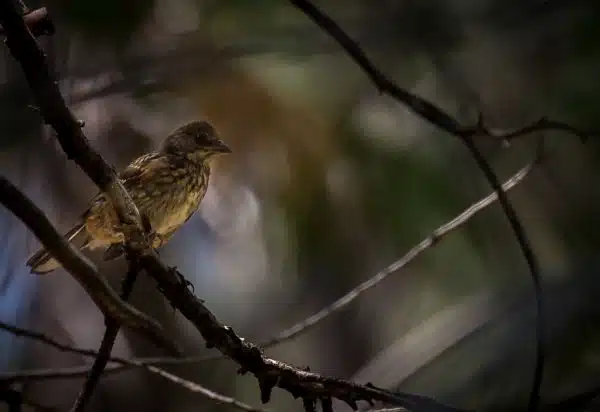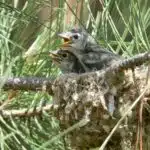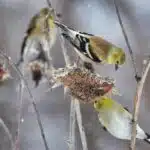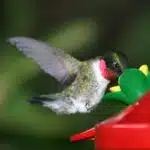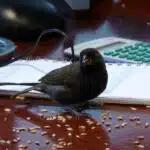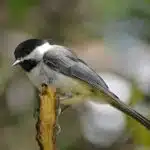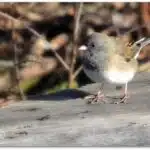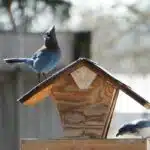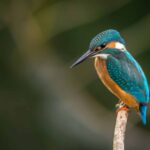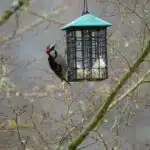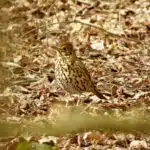As winter approaches, the temperature drops and snow starts to fall. Humans can bundle up with warm clothing and turn up the heat indoors, but what about wild birds? How do they keep warm in such harsh conditions? As a wildlife biologist, it is essential to understand the adaptations of animals to their environment, including how birds survive during the winter months.
Wild birds have several ways of keeping warm in winter. One of these is fluffing up their feathers to create an insulating layer of air. This traps heat close to their body and helps them maintain a higher body temperature. Additionally, many birds will roost together in groups for added warmth. They may also choose a roosting location that provides shelter from wind and precipitation. These behaviors allow birds to conserve energy and stay warm during times when food resources may be scarce. Understanding these adaptations can help us appreciate the resilience of wild birds and inspire us to protect their habitats for future generations.
Importance Of Understanding Winter Adaptations In Wild Birds
Birds are one of the most fascinating creatures in the animal kingdom. They have adapted to various environments, including harsh winter conditions, through a variety of physiological and behavioral mechanisms. As wildlife biologists, it is important to understand these adaptations to ensure bird conservation efforts remain successful.
Winter birdwatching can be a beautiful and rewarding experience. However, it is crucial to keep in mind that birds face many challenges during this season, including finding food and shelter while also battling the cold weather. Understanding how they adapt and survive in these conditions can enhance our appreciation for their resilience and inspire us to take action towards their conservation.
Winter birdwatchers should take note of some tips to minimize disturbance while observing birds. These include avoiding getting too close or disturbing the birds’ habitat, not feeding them or removing any food sources, and being mindful of any potential danger that may arise from extreme weather conditions. By following these guidelines, we can enjoy watching birds in their natural environment without harming them or their habitats.
Birds have many fascinating adaptations that enable them to survive harsh winters. One of the key mechanisms is insulating feathers which trap air close to the skin, providing an extra layer of warmth. In the subsequent section, we will explore this adaptation further and discuss how it helps wild birds keep warm during winter months.
Insulating Feathers: The Key To Keeping Warm
Wild birds are well adapted to withstand harsh winter conditions. One interesting statistic is that some species of birds can maintain their body temperature at a constant level, despite external temperatures dropping as low as -40°C. This remarkable ability is due to the unique structure of their feathers.
Feather structure plays a crucial role in keeping birds warm during the winter season. The outer feathers protect against wind and moisture, while the down feathers provide insulation by trapping air close to the bird’s body. Down feathers are soft and fluffy, with thousands of tiny filaments branching out from a central shaft. These filaments trap air between them, forming an insulating layer that helps retain body heat.
The effectiveness of down feathers as insulation is further enhanced by their ability to fluff up or compress depending on temperature changes. When it’s cold outside, birds can fluff up their feathers, increasing the amount of trapped air and providing additional insulation. Conversely, when it’s warmer, they can compress their feathers to reduce insulation and avoid overheating. Understanding how feather structure works to keep birds warm is just one example of the amazing ways nature adapts to survive in challenging environments.
Transition: Understanding feather structure provides insight into how these incredible adaptations work to keep wild birds warm in winter. In the next section, we will delve deeper into how feathers work to trap heat and keep birds cozy even in sub-zero temperatures.
How Feathers Work To Trap Heat
Feathers are the key to keeping wild birds warm in winter. They are composed of a central shaft with flexible branches called barbs that extend from either side, creating a flat surface. The arrangement of these barbs creates a series of interlocking hooks that keep the feathers together, forming an insulating layer around the bird’s body.
Feather anatomy plays a crucial role in thermal regulation. Down feathers are short, fluffy feathers located close to the bird’s skin that trap air and create a layer of insulation. Contour feathers, on the other hand, cover the bird’s body and provide waterproofing as well as insulation. These different types of feathers work together to maintain the bird’s body temperature by minimizing heat loss and conserving energy.
In addition to their feather anatomy, wild birds have behavioral adaptations for winter survival. These include roosting in groups for warmth, fluffing their feathers to increase insulation, and reducing their activity levels during cold weather. By utilizing these strategies along with their unique feather anatomy, wild birds can successfully survive harsh winter conditions without the need for additional external sources of warmth.
- Wild birds have specialized muscles attached to their feather follicles that allow them to control each feather individually, enabling them to adjust their insulation level as needed.
- Some species of birds will also shiver slightly when they are cold as a way to generate internal heat and warm up.
- Certain species of birds have been known to use communal roosts during winter months where they huddle together closely for warmth and protection.
Transition: While feather anatomy is essential for thermal regulation in wild birds during winter months, behavioral adaptations also play a critical role in ensuring survival. Let’s take a closer look at some of these adaptations in the next section.
Behavioral Adaptations For Winter Survival
As the winter months approach, wild birds must adapt to survive the harsh conditions. Behavioral observations have shown that many species have developed a variety of survival techniques to keep warm and conserve energy. One such technique is fluffing up feathers, which increases insulation and traps warm air close to the bird’s body. This is similar to putting on a puffy jacket in cold weather. By fluffing their feathers, birds can maintain their body temperature and reduce heat loss.
Another survival technique used by wild birds is shivering. Although shivering may seem counterintuitive, it actually generates heat by increasing metabolic activity. Birds will shiver intermittently throughout the day and night to keep warm when temperatures drop below freezing. This behavior allows them to survive without expending too much energy on movement or foraging for food.
In addition to individual survival techniques, many species of birds roost in groups during the winter months as an additional survival strategy. Roosting in groups provides safety in numbers from predators and helps conserve heat by sharing body warmth. For example, roosting chickadees will huddle together with their backs facing each other to reduce exposure to cold winds and share warmth. This behavior not only helps them survive but also provides an opportunity for social interaction during a difficult time of year for these wild birds.
Roosting In Groups: Safety In Numbers
Birds have evolved unique ways to survive harsh winter conditions, and one of these is roosting in groups. Roosting in groups has several benefits for wild birds. Firstly, it provides them with a sense of safety in numbers. When birds roost together, they can keep an eye out for predators and alert each other if there is danger nearby. This also allows them to conserve energy that would otherwise be used for vigilance.
Secondly, roosting in groups helps birds stay warm by sharing body heat. Birds that roost alone are more likely to lose body heat quickly, but when they huddle together, they form a microclimate that keeps them warm. This is especially important during extremely cold nights when temperatures can drop significantly.
There are also challenges with roosting in groups. One challenge is finding the right balance between staying close enough to share body heat and not being too close that they suffocate each other. Another challenge is finding the right location that provides adequate protection from the elements while also being safe from predators. In the next section, we will discuss how birds choose the right roosting location based on various factors such as weather conditions and habitat availability.
Transition: Now that we understand the benefits and challenges of roosting in groups, let’s explore how birds choose the right location to maximize their chances of survival during winter nights.
Choosing The Right Roosting Location
Wild birds are well adapted to survive cold temperatures in winter, but they must select the right roosting site to ensure their safety and well-being. Finding shelter from the elements is of utmost importance, with birds preferring roosting sites that are well protected by foliage or other cover. The site should also be relatively close to food sources, and provide insulation from the cold. When choosing a roosting site, birds must also consider the presence of predators, as well as the availability of adequate perching surfaces.
Finding Shelter
When winter arrives, wild birds face the challenge of finding suitable shelter to survive the cold temperatures. Some birds migrate to warmer regions, while others endure the harsh winter conditions. To ensure their survival, birds must choose the right roosting location. This involves finding a place that offers protection from wind, snow, and rain.
Winter bird migration is a common phenomenon where birds fly to warmer regions in search of food and shelter. Many species of birds travel thousands of miles each year to escape the freezing temperatures. However, some birds prefer to stay put and hibernate during the winter months. These birds conserve energy by lowering their body temperature and slowing down their metabolism.
Finding shelter is crucial for wild birds during winter. Birds need a safe place to rest and sleep without being exposed to predators or harsh weather conditions. The ideal roosting location should provide adequate insulation from the cold weather and be free from drafts. Some common shelters include dense vegetation, tree cavities, birdhouses, or roost boxes specially designed for wild birds.
In conclusion, wild birds have various ways of keeping warm during winter. While some migrate to warmer regions or hibernate, others rely on finding suitable shelter for survival. Choosing the right roosting location is vital for protecting these creatures from adverse weather conditions and predators while maintaining their body temperature. Wildlife biologists continue to study bird behavior to better understand how they adapt to different environmental challenges throughout their lifecycle.
Selecting A Roosting Site
Birds have different roosting preferences depending on their species and environmental conditions. When selecting a roosting site, birds consider the availability of food, water, and shelter. They also prioritize predator avoidance and social interaction among their flock. Some birds prefer to roost in groups for added warmth, while others choose solitary spots that offer more privacy.
In addition to social dynamics and predator avoidance, birds also look for specific features in their roosting sites. For example, trees with thick leaves or evergreen branches provide good insulation from the cold weather. Tree cavities or birdhouses also offer protection from predators and harsh wind. Other birds might opt for ground-level shelters like brush piles or dense vegetation.
When selecting a roosting location, it’s essential to consider the seasonal changes in the environment. Birds may need to adjust their roosting preferences as temperatures fluctuate throughout the year. Wildlife biologists study these behaviors to better understand how birds adapt to different environments over time. Their findings can help us create better conservation strategies that protect wild bird populations in a changing world.
Shelter From Wind And Precipitation
Wild birds have various ways of finding shelter during the winter season. One way is by utilizing natural roosting habitats such as dense foliage, tree cavities, and rock crevices. These locations provide protection from wind and precipitation. For example, some bird species prefer to roost in dense shrubs or hedges to protect themselves from harsh winds. Other birds may take advantage of tree cavities or rock crevices, which provide a warm and dry place to spend the night.
Another way that wild birds can find shelter is through DIY birdhouses. Birdhouses offer an excellent opportunity for birds to find shelter from the cold weather while also providing them with a place to raise their young during the breeding season. When constructing a birdhouse, it’s essential to ensure that it has adequate insulation and ventilation. The size of the entrance hole should also be appropriate for the type of bird species you intend to attract.
Overall, providing wild birds with shelter during the winter months is crucial for their survival. By offering natural roosting habitats or building DIY birdhouses, we can help protect these delicate creatures against harsh weather conditions. In the next section, we will discuss energy conservation methods that wild birds use to keep warm in winter without expending too much energy.
Energy Conservation Methods
- Insulation plays an important role in energy conservation for wild birds in winter. The insulation of feathers helps to prevent heat loss from the body, decreasing the amount of energy the bird needs to expend to stay warm.
- Feathers also serve to trap air, which, in turn, helps to maintain body temperature and conserve energy. The contour feathers, which are the outermost layer of feathers, are particularly important for insulation.
- In addition to insulation, wild birds may also use body shivering as a method to generate heat. Muscle contractions create heat and shivering can help to raise the bird’s body temperature.
- While shivering is an important method of thermoregulation, it is also energetically costly. Birds need to be able to balance the amount of energy they expend on shivering and the amount of heat they are able to generate.
- Birds are able to conserve energy during the winter by using a combination of insulation, feathers and body shivering. Each of these methods helps birds to maintain their body temperature and prevent heat loss.
- By understanding how wild birds use insulation, feathers, and body shivering to conserve energy, we can develop conservation strategies to help birds survive in colder climates.
Insulation
Wild birds have developed various energy conservation methods to survive the harsh winter months. One of these methods is insulation, which involves keeping their bodies warm by trapping air close to their skin. The anatomy of bird feathers plays a critical role in providing insulation. Feathers are made up of a central shaft with barbs that branch off on either side. These barbs further branch out into smaller structures called barbules, which interlock with each other to create an intricate web-like structure.
The downy feathers found beneath the outer layer of feathers are especially important for insulation. These feathers have a much finer structure than regular feathers and can trap more air per unit volume, making them more effective at retaining heat. Down insulation works by creating a barrier between the cold outside environment and the warm interior of the bird’s body. This layer of trapped air acts as an insulator, preventing heat loss through conduction and convection.
In conclusion, wild birds have evolved sophisticated energy conservation methods to keep themselves warm during the winter months. Insulation is one such method and involves trapping air close to their skin using feather anatomy and down insulation. By utilizing these mechanisms, birds conserve energy while maintaining their body temperature, allowing them to survive even in extreme weather conditions.
Feathers
Feathers play a crucial role in the energy conservation methods of wild birds. Feather anatomy is specifically designed to provide insulation and regulate body temperature, which is necessary during the winter months. The structure of feathers includes a central shaft with branching barbs that further split into smaller structures called barbules. These intricate structures interlock with each other, creating an insulating layer that traps air close to the bird’s skin.
Moreover, moulting cycles also contribute to energy conservation. During the moult, birds lose their old and worn-out feathers and replace them with new ones. This process ensures that they maintain optimum feather density for insulation and flight efficiency. Additionally, birds can control their feather positions through specialized muscles attached to their feathers, which helps regulate heat loss by adjusting their insulating properties.
In conclusion, feathers are essential for wild birds’ energy conservation methods as they provide insulation and regulate body temperature during extreme weather conditions. Feather anatomy and moulting cycles play a significant role in maintaining optimum feather density for insulation and flight efficiency. Furthermore, birds’ ability to control their feather positions is an efficient way to regulate heat loss by adjusting their insulating properties.
Body Shivering
Wild birds have various energy conservation methods to survive extreme weather conditions. As previously discussed, feathers play a vital role in providing insulation and regulating body temperature. Another energy conservation technique that birds use is body shivering. Body shivering benefits birds by increasing their metabolic rate and generating heat, which helps maintain their core body temperature.
Body shivering is a common method used by birds during cold weather to conserve energy. During this process, birds contract and relax their muscles rapidly, which generates heat by burning stored fats and carbohydrates. This mechanism helps them maintain their internal body temperature without relying on external heat sources. Moreover, body shivering also increases the bird’s metabolic rate, which means they consume more food to generate the required energy for survival.
The impact of body shivering on energy conservation in wild birds is significant. By using this technique, they can conserve precious energy reserves that could be used for other essential activities such as hunting or migration. Additionally, it helps them avoid exposure to predators by not needing to leave their sheltered areas frequently. Overall, the combination of feather anatomy, moulting cycles, and body shivering allows wild birds to survive extreme weather conditions while minimizing their energy consumption and maximizing their chances of survival.
Decreased Metabolic Rate In Winter
During the winter months, decreased metabolic rates are essential for wild birds to survive. This is because energy expenditure must be minimized in order to conserve resources and maintain body heat. The reduction in metabolic rate results in a state of torpor, which is similar to hibernation patterns observed in other animals. During torpor, the bird’s body temperature drops significantly, and most physiological processes slow down.
Winter torpor allows wild birds to endure extreme cold temperatures without expending too much energy. The reduction in metabolic rate also enables them to go longer periods without food or water as their bodies become more efficient at using stored energy sources. Birds that rely on fat stores to survive through the winter are particularly adept at entering torpor as they can conserve energy more effectively.
In summary, decreased metabolic rates during winter torpor play a critical role in helping wild birds survive through the harsh winter months. By slowing down their physiological processes and minimizing energy expenditure, these birds can conserve precious resources and maintain body heat, even when temperatures drop well below freezing. In the next section, we will explore how these birds adjust their body temperature to regulate their metabolism and maintain optimal physiological functioning during the winter season.
Adjusting Body Temperature
Wild birds have developed various physiological responses to adjust their body temperature during winter. One such adaptation is the ability to fluff up their feathers, which creates an insulating layer of air around their bodies, trapping heat and keeping them warm. Additionally, many birds have specialized muscles that generate heat when they shiver, raising their internal body temperature.
Another way birds adjust their body temperature is by decreasing blood flow to their extremities, such as their feet and beaks. By doing this, they reduce heat loss in areas that are not essential for survival. Some species of birds also huddle together in groups for added warmth, sharing body heat with each other.
Overall, wild birds have developed a range of effective strategies for adjusting their body temperature during winter. These adaptations allow them to survive in harsh environments where food and shelter may be scarce. Understanding these physiological responses can help us appreciate the incredible resilience and resourcefulness of these remarkable creatures.
As we have seen, adjusting body temperature is just one way that wild birds cope with the challenges of winter. In addition to adapting to cold temperatures, many species must also contend with food scarcity and other survival strategies. Let us now explore how wild birds manage to find enough food to sustain themselves through the winter months.
Food Scarcity And Survival Strategies
- Wild birds employ a range of foraging techniques during periods of food scarcity in order to survive.
- Migration is a common strategy employed by wild birds to obtain food resources in other regions.
- Adaptations to the cold, such as increased size of feathers, a reduction in body size, and a decrease in metabolic rate, allow wild birds to conserve energy and survive cold temperatures.
- Foraging strategies employed by wild birds in winter often involve searching for food in sheltered areas such as beneath snow cover or in tree canopies.
- Wild birds also employ strategies such as hoarding food to survive times of food scarcity.
- Wild birds also rely on the formation of social groups to increase their foraging efficiency and survival during times of food shortages.
Foraging Techniques
The onset of winter brings about new challenges for wild birds. The most pressing issue is the scarcity of food sources. Foraging becomes an important strategy for survival during these harsh times. However, it’s not as easy as just flying around and picking up food. Wild birds face a variety of foraging challenges that require them to adapt their techniques.
To overcome these challenges, wild birds have developed unique foraging techniques that allow them to find food in difficult environments. Some species, such as woodpeckers and nuthatches, use their strong beaks to dig through tree bark to find insects hiding underneath. Others, like the American Goldfinch, rely on seeds that they store in their crop to provide sustenance during harsh winters.
Despite the difficulties they face, wild birds are able to persevere through the winter months thanks to their resourcefulness and adaptability. By utilizing various foraging techniques and being strategic about where they look for food, these resilient creatures are able to survive even when resources are scarce. This ability is a testament to the incredible resilience and ingenuity of nature’s creatures.
Migration
Winter birdwatching provides an opportunity to observe the foraging techniques of wild birds as they face the challenge of food scarcity. While some species have adapted to survive the winter by developing unique foraging strategies, others have evolved to migrate to locations with more abundant food sources. Migration is a natural response to environmental changes and is a crucial survival strategy for many bird species.
Birds that migrate during the winter months are able to access food resources that would otherwise be unavailable in their breeding grounds. Some species, such as Arctic Terns, travel thousands of miles each year between their breeding grounds in the Arctic and their wintering grounds in Antarctica. The energy required for these long journeys is significant, but the reward of abundant food sources makes it worthwhile.
The environmental impact of migration on wild bird populations is complex and varies depending on factors such as habitat loss and climate change. However, it is clear that migratory birds play an important role in maintaining biodiversity and ecosystem function. As we continue to study and understand the behaviors of migratory birds, we can work towards better conservation efforts that support their survival and well-being.
Adaptations To The Cold
Birds that stay in colder regions during the winter months face significant challenges in finding enough food to survive. While some birds migrate to warmer locations, others have developed adaptations to help them cope with the harsh conditions. One such adaptation is hibernation, which some bird species utilize to conserve energy and reduce their metabolic rate during periods of low food availability.
Hibernation in birds involves a state of reduced activity and metabolism, allowing them to conserve energy and survive for extended periods with limited food resources. This adaptation is common in some bird species that inhabit regions with extreme cold temperatures, such as the snowy owl. During hibernation, these birds lower their body temperature and slow down their heart rate, thus reducing their need for food intake.
Another adaptation seen in some bird species is winter plumage. As the name implies, this refers to changes in a bird’s feathers that occur during the winter months to help them better tolerate colder temperatures. Some species grow thicker feathers during this time, while others change the coloration of their feathers to better blend in with their surroundings. These adaptations help birds maintain their body heat and conserve energy while they search for food in areas where it is scarce.
Overall, birds have evolved a variety of strategies for surviving during periods of food scarcity caused by cold weather conditions. From hibernation and winter plumage adaptations to migration and unique foraging techniques, these survival strategies allow birds to thrive despite challenging environmental conditions. Understanding these adaptations can provide insights into how we can support wild bird populations through conservation efforts that preserve their natural habitats and protect them from human-driven threats such as climate change and habitat loss.
Migration As A Winter Adaptation
Wild birds have several adaptation strategies to survive the harsh winter months. One of the most effective and commonly observed is migration. Migration patterns vary among bird species, but generally, they involve moving to warmer climates with more available food sources. Birds that migrate for the winter often travel long distances, sometimes spanning entire continents or even crossing oceans.
The decision to migrate is usually triggered by environmental cues such as decreasing daylight hours and cooling temperatures. These cues signal to birds that resources will become scarce, and it’s time to move on. Some birds also use celestial navigation or magnetic fields to navigate during their journey. Interestingly, not all birds migrate; some species remain in their cold environments year-round and have other unique adaptations like growing thicker feathers or huddling together for warmth.
Overall, migration is an essential adaptation strategy for many wild bird populations during the winter season. It allows them to access more abundant food sources and avoid harsh weather conditions that could be lethal without proper preparation. Understanding these migration patterns can provide insight into bird behavior and ecology, ultimately aiding in conservation efforts for these vital members of our ecosystems.
As we delve deeper into understanding winter bird populations, we must also consider other factors that affect their survival and well-being. By examining habitat availability, predator-prey dynamics, and climate change impacts, we can better protect these fascinating creatures while also serving our natural world’s broader needs.
Understanding Winter Bird Populations
Migration patterns of winter bird populations can be studied by tracking the movements of individuals or groups of birds. Feeding habits of winter birds can vary greatly depending on the availability of food sources in the region. Adaptation strategies of winter birds may include increased energy savings through changes in body temperature, increased feather insulation, and alterations to behavior. Research has shown that some winter bird species are able to remain active at temperatures that would be otherwise fatal. Migration patterns and flight distances can be studied to determine the effects of climate change on winter bird populations. Studies of winter bird populations can also provide insight into their ability to adapt to changing environmental conditions.
Migration Patterns
Wild birds that remain in cold regions during winter have to adapt to the harsh weather conditions. Understanding bird behavior is key to understanding how these birds survive the winter months. One of the most common behaviors that enable birds to cope with the harsh winter is migration. Many bird species migrate from colder regions to warmer areas in search of food and better living conditions.
Migration patterns are a crucial factor in understanding winter bird populations, as they determine which species will be present in a given area during the winter months. The impact of climate change on migration patterns has been a significant concern for wildlife biologists. As temperatures continue to rise, some bird species may no longer need to migrate long distances for survival, while others may be forced to move further north or south in search of suitable habitats.
Birds that do not migrate must find other ways of adapting to the cold weather. These adaptations include puffing up their feathers, huddling together for warmth, and roosting in sheltered areas such as tree cavities or under bridges. By studying these behaviors and adaptations, we can gain insight into how wild birds keep warm during the winter months and better understand how climate change impacts their survival strategies.
Feeding Habits
Understanding winter bird populations involves studying various aspects of their behavior and adaptations. In addition to migration patterns, feeding habits are another crucial factor in determining which bird species will be present in a given area during the winter months. As the availability of food sources can greatly impact a bird’s survival, it is important to understand how different species adapt their feeding habits to cope with the cold weather.
During the winter months, many of the insects and fruits that birds rely on for food are no longer available. As a result, some species must switch to alternative food sources such as seeds, nuts, and berries. Other birds may turn to scavenging or even predation to supplement their diets during this time. Understanding which food sources different species rely on can help us predict which birds will be present in a given area during the winter months.
In addition to changes in diet, some bird species have unique feeding habits that enable them to survive in cold regions during the winter months. For example, some birds such as woodpeckers and nuthatches store food for later consumption by hiding it in tree bark or crevices. Others such as chickadees have been observed caching individual seeds in specific locations, making it easier for them to find food when resources are scarce. By studying these feeding habits and adaptations, we can gain insight into how wild birds survive during the challenging winter season.
Adaptation Strategies
Understanding winter bird populations requires a deep understanding of the behavioral and physiological changes that occur in different bird species during the cold season. One of the key areas of study related to this is adaptation strategies. Many birds have unique adaptations that enable them to survive the harsh winter weather, including changes in diet, feeding habits, and other physiological changes.
One of the most significant adaptation strategies employed by birds during winter is changing their diets. As food sources become scarce due to the cold weather, many species must switch to alternative food sources such as seeds, nuts, and berries. Other birds may turn to scavenging or even predation to supplement their diets during this time. Understanding which food sources different species rely on can help us predict which birds will be present in a given area during the winter months.
In addition to dietary changes, many bird species also exhibit unique behavioral adaptations that enable them to survive in cold regions during winter. For example, some birds such as woodpeckers and nuthatches store food for later consumption by hiding it in tree bark or crevices. Others such as chickadees have been observed caching individual seeds in specific locations, making it easier for them to find food when resources are scarce. By studying these adaptation strategies and behavioral changes, we can gain valuable insights into how wild birds survive during the challenging winter season without direct assistance from humans.
Conservation Efforts For Wild Birds
The survival of wild birds in winter is a conservation challenge, especially in areas where their natural habitats have been disrupted or destroyed. Habitat loss and fragmentation leave these birds vulnerable to reduced food availability, harsh weather conditions, and increased predation. In recent years, habitat restoration efforts have been implemented to mitigate these challenges.
Habitat restoration involves the creation of suitable habitats for wild birds by planting native vegetation and providing nesting sites. This type of intervention can improve the resilience of wild bird populations during the winter season. While such efforts are often successful, they require long-term commitment from local communities, government agencies, and conservation organizations.
Conservation efforts for wild birds are critical to ensuring their survival in the face of changing environmental conditions. Habitat restoration programs provide an effective means to protect wild bird populations through the provision of suitable habitat and food resources. Despite these efforts, however, wild birds continue to face numerous challenges during the winter season. In the subsequent section, we will explore the resilience of wild birds in winter and how they cope with the harsh conditions they encounter.
Conclusion: The Resilience Of Wild Birds In Winter
Despite the many conservation efforts to protect wild birds, climate change remains a persistent threat that poses significant challenges for these creatures. Winter is particularly harsh for wild birds, and they must find ways to keep warm in order to survive. However, despite the challenges posed by climate change, wild birds have shown remarkable resilience in adapting to these changes.
One of the ways in which wild birds keep warm in winter is through their feathers. Feathers provide excellent insulation and help trap heat close to the bird’s body. Additionally, some species of birds will fluff up their feathers during the winter months to create an even thicker layer of insulation. Another way that wild birds keep warm is by roosting in sheltered areas such as tree cavities or birdhouses.
While climate change has undoubtedly had an impact on wild bird populations, it is important to note that many species have adapted remarkably well. For example, some species have shifted their ranges northward as temperatures have warmed, while others have altered their migration patterns in response to changing weather patterns. Despite these adaptations, however, there are still significant challenges facing wild birds in winter due to climate change.
Resilience vs vulnerability: a comparative study
Resilience: Wild birds have demonstrated remarkable resilience despite the challenges posed by climate change.
Vulnerability: Wild birds remain vulnerable to changes caused by a changing climate and human activity.
Climate change impact: challenges for wild birds in winter
Changes in temperature and weather patterns can disrupt breeding cycles and food availability.
Loss of habitat due to human activities such as deforestation and urbanization can make it difficult for wild birds to find suitable roosting sites.
Extreme weather events such as storms and droughts can also pose a significant threat to wild bird populations.
In summary, while there are certainly challenges facing wild birds during the winter months due to climate change, it is important to recognize their remarkable resilience in adapting to these changes. By understanding the ways in which wild birds keep warm and the challenges they face, we can better protect and conserve these important members of our ecosystem.
Conclusion
Understanding winter adaptations in wild birds is critical to their survival. Insulating feathers are the key to keeping warm, and understanding how they work can help us appreciate the resilience of these creatures. Feathers trap heat by creating a layer of air between them, which acts as an insulator. This makes them incredibly effective at keeping birds warm even in the harshest of conditions.
In addition to insulating feathers, wild birds have behavioral adaptations for winter survival. Roosting in groups provides safety in numbers, while migration allows birds to escape harsh winter weather altogether. Understanding these adaptations is crucial for conservation efforts aimed at preserving wild bird populations.
The resilience of wild birds in winter is truly remarkable. Despite the challenges they face, they continue to adapt and survive in even the most inhospitable environments. As wildlife biologists, it is our duty to study and protect these incredible creatures so that future generations may also marvel at their strength and adaptability. By working together to preserve their habitats and support their populations, we can ensure that wild birds will continue to thrive for generations to come.
Image Credits
- “Wild Bird” by Maxinux40k (featured)

